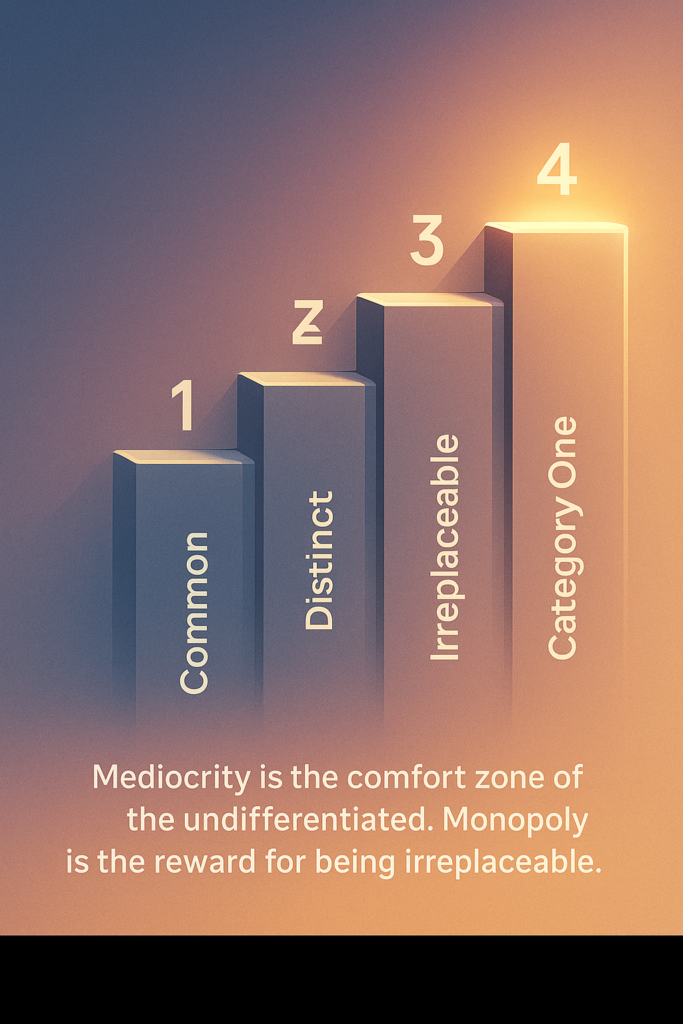
How differentiation and defensibility shape value — for companies and individuals alike
🧭 The Parallel Worlds of Strategy and Self
In business strategy, barriers to entry determine how hard it is for others to compete in your market.
In personal growth, your Unique Selling Proposition (USP) defines what makes you irreplaceable.
Though these belong to different spheres, they share a single truth:
Uniqueness plus defensibility equals enduring value.
When your uniqueness can’t be easily replicated, you create a natural moat around your worth — whether that worth is measured in market share or personal influence.
💼 Porter’s Guardrails — Building Moats That Last
Michael Porter’s Five Forces model teaches that high barriers to entry protect profitability.
Brands like Apple, Tesla, and Netflix thrive because imitation is expensive.
They own ecosystems, data, and emotional loyalty — each a wall against competition.
The same applies to individuals.
Your moat may be your credibility, creative method, or the trust you’ve built over time.
The stronger your differentiation, the longer your advantage.
🧠 The Resource-Based View — Turning Skills into Moats
The Resource-Based View (RBV) argues that true advantage comes from resources that are:
Valuable, Rare, Inimitable, and Non-substitutable (VRIN).
That framework doesn’t just apply to corporations.
Your USP — your unique blend of insight, craft, and personality — is a personal VRIN asset.
If others can’t easily copy your thinking or your process, your value naturally compounds.
A strong USP is not a tagline. It’s a protective structure built on mastery.
🌊 The Blue Ocean Mindset — Creating Space Instead of Fighting for It
Kim and Mauborgne’s Blue Ocean Strategy reminds us that the surest way to win is not to fight at all.
Companies create “blue oceans” by innovating where competition is irrelevant.
Individuals can do the same: find the intersection of what you love, what you’re great at, and what others truly need.
Don’t fight for visibility — create a space that only you can fill.
Your USP is the compass; your barrier to entry is the ocean current that keeps you ahead.
📈 The Law of Exponential Value
In both business and life, value does not grow linearly — it compounds.
When your uniqueness and defensibility rise together, perception and pricing power accelerate.
| Position | Differentiation | Defensibility | Perceived Value |
|---|---|---|---|
| One in 1000 | Low | Low | Ordinary |
| Top 10 | Moderate | Somewhat defensible | Noticeable |
| Top 3 | High | Defensible | Premium |
| Top 1 | Singular | Strong moat | Exponential |
Formula: Distinctiveness × Defensibility = Exponential Value.
🧱 Building Your Personal Barriers to Entry
- Identify your uniqueness — What can you do or explain better than most?
- Reinforce it — Develop proof through portfolio, projects, and stories.
- Protect it — Build reputation, systems, and selective access.
- Expand it — Keep learning faster than others can copy.
A moat must evolve faster than others can cross it.
🌟 From Mediocrity to Monopoly
Every company and individual faces the same equation:
- Without a USP, you’re replaceable.
- Without barriers, you’re temporary.
- With both, you’re invaluable.
“Mediocrity is the comfort zone of the undifferentiated.
Monopoly is the destiny of the truly unique.”
